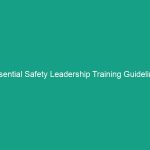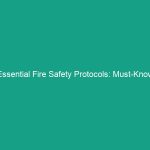Good Morning Team!
Today, we’re going to discuss an important topic that affects our health and Safety at work: Essential West Nile Virus Guidelines: Protect Yourself and Your Team. As the seasons change, so do the risks associated with mosquito-borne diseases, like the West Nile Virus (WNV). Understanding how to protect ourselves and our teammates is crucial for maintaining a safe work Environment.
Understanding West Nile Virus
West Nile Virus is a viral infection spread primarily by mosquitoes. It can cause serious illness or even death, particularly in older adults and those with weakened immune systems. It’s essential to recognize that WNV is not just a summer nuisance; it poses a significant threat to our health, especially in outdoor work environments.
A common misconception is that WNV only affects those living in rural areas. In reality, urban areas can also experience outbreaks, and mosquitoes can carry the virus across wide distances. Understanding the importance of West Nile Virus guidelines helps us protect ourselves not just from the vector, but also from the potential health implications.
Key Hazards, Risks, and Safety Considerations
When discussing West Nile Virus, it’s vital to identify specific Hazards and risks associated with it, particularly in outdoor work settings. Here are some key points to consider:
- Exposure to Mosquitoes: Employees working outdoors are at higher risk of being bitten by mosquitoes, especially during dawn and dusk when these insects are most active.
- Potential for Severe Illness: While many people infected with WNV do not exhibit symptoms, approximately 1 in 5 develop a fever and other symptoms. Severe illness can occur in about 1 in 150 cases.
- Environmental Factors: Stagnant water near job sites can serve as breeding grounds for mosquitoes, increasing the risk of exposure.
Ignoring safety protocols can lead to serious health consequences for employees. In the past, companies have faced severe repercussions due to outbreaks linked to outdoor work activities, including legal lawsuits and increased insurance costs. Therefore, understanding and implementing WNV guidelines is critical for employee safety.
Best Practices, Procedures, & Actionable Advice
Now that we understand the risks, let’s discuss practical steps we can take to mitigate these hazards:
1. Use Insect Repellent
Always apply an EPA-registered insect repellent that contains DEET, picaridin, or oil of lemon eucalyptus. Reapply as directed, especially after sweating or if you’ve been in water.
2. Wear Protective Clothing
When working outdoors, wear long sleeves and long pants to minimize skin exposure. Light-colored clothing is preferable as it’s less attractive to mosquitoes.
3. Eliminate Standing Water
Regularly check the worksite for stagnant water and take steps to eliminate it. This includes emptying containers, cleaning gutters, and ensuring proper drainage.
4. Schedule Work Wisely
Try to schedule outdoor work during times when mosquitoes are less active, typically in the late morning or early afternoon.
5. Educate and Train
Regularly provide Training sessions on WNV and empower employees to recognize the signs of mosquito breeding and potential health risks. Share information on how to report any concerns.
Case Study: A Real-World Incident
In 2018, a landscaping company experienced a WNV outbreak after failing to implement mosquito Control Measures. Several employees fell ill, resulting in significant downtime and loss of productivity. This incident serves as a critical reminder of the importance of adhering to Safety Guidelines and proactively mitigating risks associated with West Nile Virus.
Regulations, Standards, and Compliance
It’s essential to be aware of regulatory frameworks surrounding mosquito control and WNV Prevention:
- OSHA Standards: Familiarize yourself with osha’s guidelines on Workplace Safety, particularly those concerning vector-borne diseases.
- Company Policies: Review your company’s specific policies regarding outdoor work and mosquito Control Measures. Compliance with these policies not only protects you but also ensures the company meets legal requirements.
Compliance is critical in safeguarding employees’ health and maintaining a safe work environment. Remember, following guidelines isn’t just about avoiding penalties; it’s about protecting yourself and your team.
Employee Engagement & Discussion
Before we wrap up, let’s open the floor for discussion. I want to hear your thoughts:
- What safety challenges have you encountered related to mosquito bites or West Nile Virus?
- Have you noticed any areas at our worksite that may be attracting mosquitoes?
- What additional measures do you think we could implement to enhance our safety protocols?
Your feedback is invaluable. By sharing experiences and ideas, we can work together to create a safer workplace.
Conclusion & Key Takeaways
In conclusion, protecting ourselves from West Nile Virus is a shared responsibility. By understanding the risks, implementing Best Practices, and staying informed about Regulations, we can significantly reduce our chances of exposure. Remember:
- Use insect repellent and wear protective clothing.
- Eliminate standing water and schedule outdoor activities wisely.
- Stay informed and engage in discussions about safety.
Thank you for your attention today and for your commitment to safety. Let’s prioritize our health and well-being as we continue our work. Together, we can create a safer environment for everyone.


